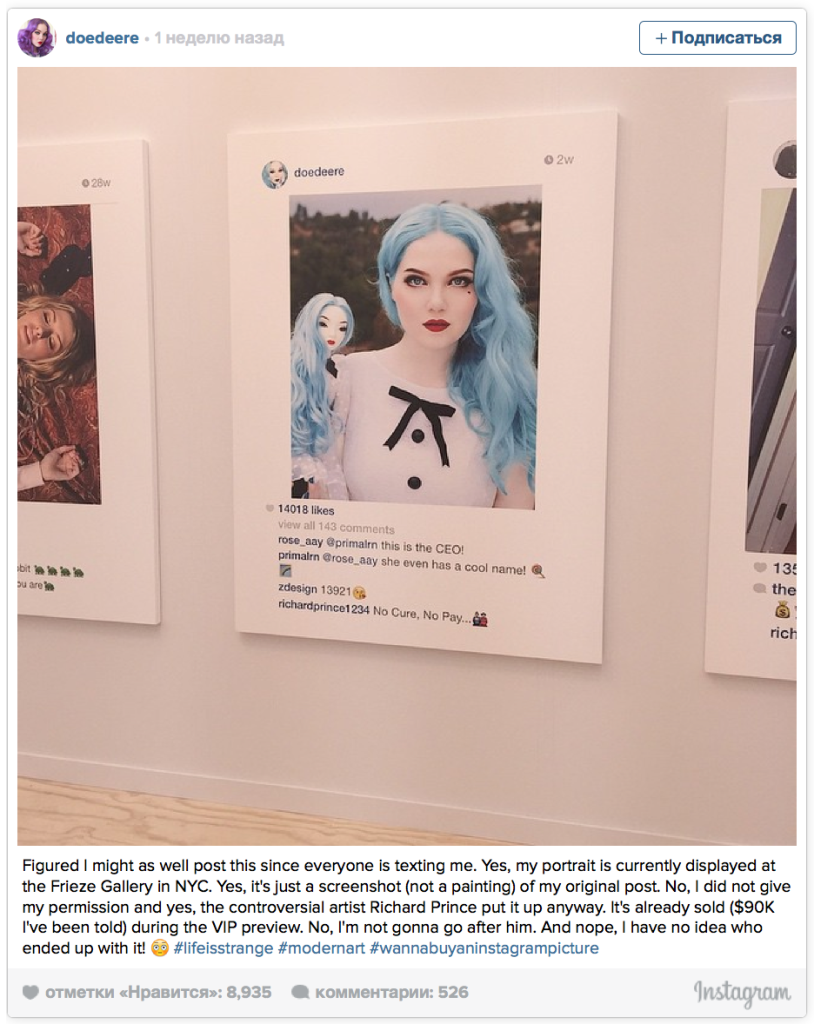In New York, the artist sells someone else's Instagram photos as art.
At the Frieze Contemporary Art Fair in New York, artist Richard Prince for $ 90 000 sold a screenshot from a stranger Instagram.
The entire exhibition of Prince’s works, exhibited at the Frieze fair, consisted of enlarged “screenshots” of Instagram footage of people unknown to the artist, The Independent reports. Prince did not ask for permission to reprint the works, and he does not intend to share the proceeds from the sale.
In total for the exhibition Prince “borrowed” 37 screenshots. All of them were united by the fact that the artist left his comments under them. Under the image of a girl sold for $ 90 000, the artist wrote: “No cure, no pay” - and put a smiley.
The author and the heroine of the picture for the sale of their work for almost $ 100 000 reacted peacefully. The girl under the nickname Doe Deere wrote: “Yes, my portrait was exhibited at Frieze. Yes, this is a screenshot (not a picture) of my original post. No, I did not give my permission. And no, I'm not going to prosecute Prince in court. ”
The incident at Frieze is not the first time Richard Prince has posted “screenshots” of someone else’s footage. Last year, a similar exhibition was held at the Larry Gagosian Art Gallery in New York. The works were then exhibited only for private viewing and, according to sources in the New York Post, sold for up to $100. Among the exhibits were “screenshots” of celebrities.
Richard Prince copies and sells other people's work profitably for more than a year. Back in 70, he began to process other people's photos and images from magazines and pass them off as his own. A resounding success awaited the work of "Cowboy." To advertise Marlboro, Prince retakes shot by photographer Sam Abel. And in 2007, the picture was sold at Sotheby's for a record $ 3,4 million.
Who else of the artists used other people's work
“Painting has come to an end. What could be more perfect than this propeller?” - exclaimed Marcel Duchamp, struck by the beauty of an ordinary propeller at the 1912 aviation exhibition. A year later, the French artist presented the world with the first “ready-made” - a bicycle wheel attached to a stool. A new term began to be used to describe works of art created from borrowed elements. For example, Pablo Picasso loved to create his famous collages from newspaper clippings.
Robert Rauschenberg
American artist Robert Rauschenberg said: "No matter what I do, I always felt that I did not own the materials as much as I collaborated with them." Rauschenberg, who won the main prize of the Venice Biennale in 1964, often attracted the work of other authors to this “collaboration”. For example, in 1953, the artist simply erased the drawing of Willem de Kooning and put it under his own name and title “The erased drawing of Kooning”. It was one of the first works of Rauschenberg, and she glorified him.
Jeff Koons
One of the most expensive contemporary artists, American Jeff Koons, is not averse to borrowing a successful image from his colleagues. Moreover, such borrowing even brought Koons to court. In 1991–1992, photographer Art Rogers fought a lawsuit against the artist. A few years earlier, he had taken a photo of a couple holding eight puppies and resold it for reprints on greeting cards. Jeff Koons also liked the photo. He used it in his String of Puppies series of sculptures, which he sold successfully. Rogers sued Koons for copyright infringement and won—apparently, the judge had no idea what a “readymade” was.
Yuri Albert
Russian conceptual artist Yuri Albert is called the master of accepting "ironic quotation." In 2011, Albert received the Kandinsky Prize, and the Moscow Poll became his winning project.
The installation of eight tables with questions that were asked to answer “yes” or “no”, and then omit the ballots in the transparent ballot boxes, strongly resembled the work of German artist Hans Haacke MoMA Poll 1970 of the year. Moscow Poll Alberta continued a number of his projects related to the use of other people's works.
John baldessari
In 2013, the first exhibition of American conceptual artist John Baldessari took place in Moscow. In the capital, presented his work from the so-called "double" series. The artist used fragments of the textbook paintings by Courbet, Gauguin, Malevich and others and compared them with another image or text. In addition, throughout his career, Baldessari did not stop playing with images of popular culture.
Subscribe to ForumDaily on Google News











